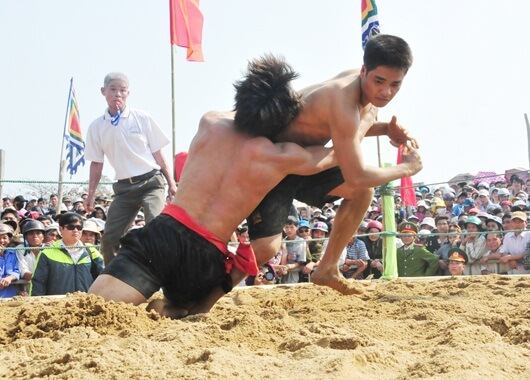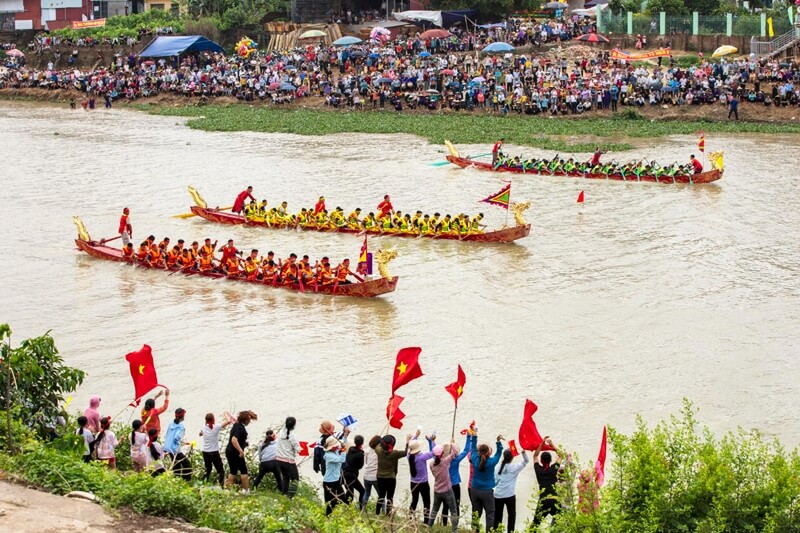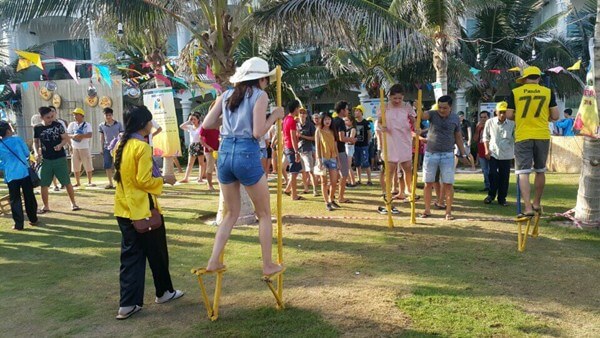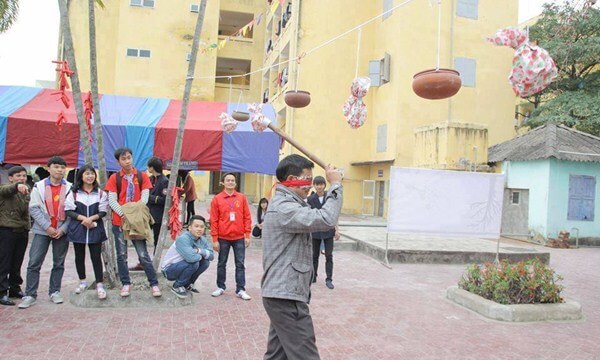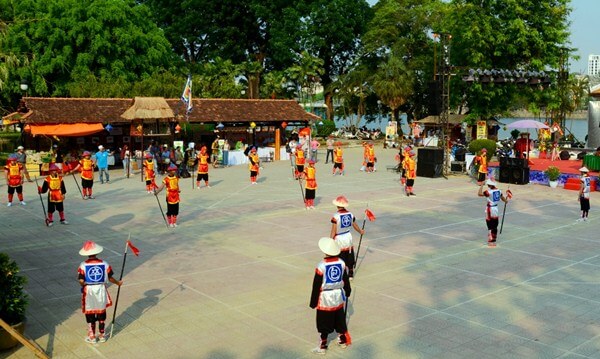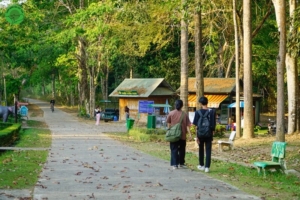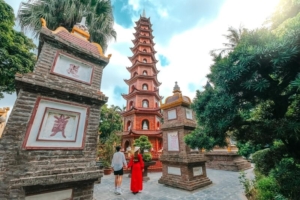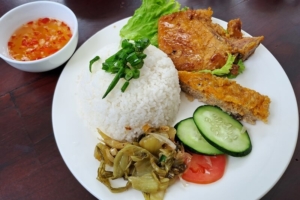In each community, there are always group games that bear the deep-rooted cultural imprint of that community. These games serve as a thread connecting the solidarity of individuals in the community and are a living testament to Vietnam’s rich heritage.
Over time, these collective games became a combination of traditional games with important meanings associated with the culture of each land.
In Vietnam, many interesting traditional folk games have lived in people’s lives through a long history of development and thousands of years of culture.
Let’s check the most popular ones!
1. Wrestling
Many Vietnamese people love this traditional game. According to many documents, Mrs. Le Chan, the pioneer general of the Trung Nu Vuong (AD 41-43), initially used wrestling to select healthy men to form an army to expel Han officials and regain the throne and sovereignty for the nation. Since then, wrestling has spread widely among the public and has become a cultural game in the country.
The space for the game to take place is often in communal courtyards and village courtyards, which have large areas. The locals built a circular arena with soft sandy ground called the Wrestling Arena.
A wrestling match, also known as “Keo Vật,” is a competition between two wrestlers. According to traditional Vietnamese wrestling rules, these wrestlers usually do not discriminate in age, weight, or even gender. This inclusivity reflects the spirit of unity and equality in Vietnamese culture.
As long as participants are confident enough about themselves and their health, they can register to participate and step into the wrestling arena to compete together.
During the match, the two wrestlers use techniques and blows to knock the opponent down on their backs to the floor, leaving their backs dirt and bellies white. The wrestler, who has beaten “white bellies and dirt back,” is the loser. The match will end, and the victory belongs to the remaining wrestler.
Currently, Vietnam still has many famous traditional wrestling festivals, such as the Lang Sinh Wrestling Festival in Thua Thien Hue Province, Phu Tai Village Wrestling Festival in Bac Giang Province, Vinh Khe Village Wrestling Festival in Hai Phong City, wrestling at the festival of King Mai Temple in Nghe An Province, and Mai Dong Wrestling Festival and Hong Ha Wrestling Festival in Hanoi.
These wrestling festivals, held at the beginning of the lunar new year every year, are a thrilling spectacle that attracts many people to compete, watch, and cheer.
2. Boat Racing
With its terrain of dense rivers and long coastlines running from North to South, Vietnam has become a premise for developing an agricultural culture associated with rivers. This is also why riverboat racing has become an outdoor traditional game that receives love from the public across the country.
Vietnamese traditional boat racing includes team competition, divided into three main contents: men’s boat racing, women’s rowing, and mixed men’s and women’s boat racing. Based on these contents, there are short and long boat races depending on the locality and tournament.
With short boats, the number of athletes participating ranges from 10 to 14 people per boat. The number of athletes in the long boat category ranges from 18 to 22 people per boat. The team includes a steering wheel, a beating drum person, a water scooper, and rowers.
These athletes are rural workers who live year-round by fishing on the river. The boat racing festival became a momentous occasion for them to gather and compete together.
The race distance of each boat race is significantly different, ranging from 4-5km for short races to 14-15km for long races. To complete these distances, the racing boat teams must circle many times through two target spots located at both ends, with a distance of 500m to 1,000m.
Every boat racing festival attracts the attention, concern, and encouragement of many people, creating great excitement. The festival usually occurs at the beginning of the new year and celebrates the National Day of September 2 or the essential anniversaries of each locality.
3. Walking on Stilts
Although stilts appear in many places worldwide, this is an ancient Vietnamese game in almost all regions.
Many theories say that stilts were created long ago when people’s lives were backward, and there were few means to support labor, such as boats, cars, and machinery. People created pairs of stilts to move through swamps in the rainy season or fish in river and sea basins. It was like a way for them to extend their legs when needed.
To create a pair of stilts, the Vietnamese use old bamboo stems soaked in mud for many months until the bamboo is strong and slightly dry. Next, they attach two supports to the bamboo body to place the feet.
Depending on each person’s height and ability, the position of the foot base is high or low. Some pairs of stilts have supports from 1.5m to 2m high, while the average is usually around 0.5m.
Nowadays, stilts have become a popular traditional game, often appearing in different forms at festivals or New Year’s Day, such as performing the art of stilt walking, racing on stilts, soccer on stilts, and stilt butting.
Occasionally, the stilt game is also introduced during some festivals, creating opportunities for visitors to experience it. This activity attracts a lot of excitement from participants, including tourists from all over the world. Therefore, don’t hesitate to try it out as soon as you have a chance.
4. Smash a Clay Pot
This fork game is purely entertaining. It mainly appears during Tet holidays and village festivals, attracting the public’s attention for fun.
The rules of the pot-smashing game are simple: The organizer will hang a clay pot at the height of a person’s face. The person participating in the funny game will stand about 10-15 steps from the pot location. The organizing committee will give the player a bamboo stick from 0.5m to 0.7m and blindfold the player with a mask or silk strip.
The player moves to the pot’s location and then uses a bamboo stick to break the clay pot. If the clay pot breaks, the player wins and will receive a small gift.
The pot-smashing game not only excites the players but also creates refreshing laughter for the viewers. The difficulty of the player having to move to the position of the pot and swing the stick while blindfolded creates suspense, mixed with a bit of funny excitement, full of innocence, causing laughter.
Some people participate in the pot-smashing game as an effective way to relieve stress. The moment the pot bursts into the air, it sounds crispy and refreshing. Try this game, and then you will realize it is a fun and exciting Vietnamese game.
5. Playing Card in Huts
Bai Choi (Playing Card in Huts) is a unique folk game from the Central region of Vietnam. UNESCO has recognized it as an intangible cultural heritage of humanity.
According to many research documents, in the past, people’s lives in the Central region mainly depended on growing fruit and food in the fields. At that time, many wild animals came to destroy the crops. People built high huts on the forest’s edge and at the top of the fields to protect the fruits of their labor and assigned young men to guard them.
The hut guards devised a way to sing and answer together to avoid boredom. At the same time, they used cards with unique shapes and interesting names, such as Nhut Tro, Nhi Cuc, Tam Toc, Tu Tuong, etc., to make the singing theme (depending on the locality, this deck has 27 or more cards, up to 32 cards).
Gradually, a unique and indispensable card game was formed in the Central countryside. Villagers gathered to play card games on leisure, festivals, and Tet days.
Coming to the Bai Choi festival, you will enjoy engaging and fun song-and-answer performances. The influence of folk songs is imbued with the sincere love of the Central people and, at the same time, mixed with a bit of irony and humor, making listeners passionate and attached.
Currently, traveling to Hoi An Ancient Town, you will have the opportunity to participate in the card game festival, held at 7:00 p.m. every night in the central area of the old town.
6. Swing
This popular game is one of the well-known folk activities that is artistic and highly entertaining. It often occurs on Tet or significant festivals and is mainly famous in Vietnam’s northern and north-central regions.
To organize a swing game, people must first build a swing tree. The location chosen to erect a swing tree is usually the village stadium area or on open land with vast open space.
A swing tree includes a pole and one or two swing arms. The swing pole comprises 6 to 8 long bamboo trees, firmly buried deep into the ground in a cross position, with their ends together.
The swingarm is also made from two long bamboo trees, which are solid but slim and have a smoother surface. The upper ends of these two bamboo trees are attached to the swing pole’s upper ends. The lower end is connected by a horizontal bamboo bar to provide a foothold for the swinger.
When swinging, people can swing one or two people together. Players use their pushing power and pull movements to swing the foothold from side to side. The higher you swing, the more attractive the game becomes. The person who controls the swing gets the highest will be the winner.
Coming to the Northern Delta of Vietnam in the early spring, you will be impressed by the image of couples in bright costumes swinging together on swing trees. Amid the bustling cheers of onlookers, they seem to be flying in the air, creating a breathtaking scene.
Don’t hesitate to go up the swing tree to join the joyful, festive atmosphere of the local people. This activity will leave you with many unforgettable memories. But remember, there is a risk when the swing goes up higher.
7. Go on Monkey Bridges
Monkey bridge is a typical game in the southern region of Vietnam. Because of the challenges it creates, this moving game requires players to have agility, flexibility, and high-balance skills. At the same time, Monkey Bridge also brings excellent excitement to viewers, so it attracts a large number of participants.
Monkey bridges are said to have first appeared in the Mekong Delta region, with a dense canal system. To create a path through these interlaced canals, people used a bamboo or coconut tree trunk to cross from one bank to another, creating a unique bridge.
Monkey bridges can have handrails or no handrails and are extremely slippery and difficult to walk on. For this reason, a Monkey Bridge play has become an exciting folk game.
Nowadays, before organizing the monkey bridge game, people build a bridge in a canal with a shallow water level or on a large surface with soft sand.
The bridge consists of a sturdy bamboo stem 5-10 m long. One end of the bamboo tree is fixed, and the other is left free or hung on a string. This bamboo tree is 0.5m to 1m above the water surface or ground.
The winning player is the one who goes all the way, from the starting point to the other side of the bridge and back to the correct starting line. Because of the game’s difficulty, the winner often receives a desirable cash reward.
Witnessing a complete monkey bridge performance is extremely exciting for viewers. It’s like a lively circus art performance.
8. Tug of War
Tug of war is a fun game that is played in many parts of the world. In Vietnam, it is considered a folk game with a high community spirit, often occurring during festivals or group activities.
In 2015, tug-of-war game rituals in Cambodia, the Philippines, Korea, and Vietnam were recognized by Unesco as a representative multinational intangible cultural heritage of humanity.
There are currently two forms of tug-of-war in Vietnam: pulling with a rope and pulling directly with hands. The rules of tug-of-war with a rope are similar to those prevalent in countries worldwide.
In a hand-to-hand tug-of-war, the two leaders of each team hold hands. The members behind him wrap their arms around the belly of the person in front and pull. The losing team is the team whose leader is pulled across the pre-determined line.
Regardless of the form of tug-of-war, the number of members of each team is unlimited, and it includes the following categories: male team, female teammates, or male and female combination.
Players must be healthy and have reasonable posture and movements to win the tug-of-war game. At the same time, smooth coordination among team members must also be present.
Thanks to its flexible nature and easy rules, tug-of-war has become popular and received widespread response from players. It also brings a lot of laughter to viewers.
9. Human Chess
Human chess often appears at large-scale traditional festivals in Vietnam. This artistic Vietnamese folk game combines the art of playing Chinese chess and performing traditional Vovinam martial arts.
Accordingly, the 32 chess pieces in the Chinese chess set will be replaced by 32 boxers, including 16 men and 16 women. These boxers are divided equally into two teams, acting as red and green chess pieces and moving on the chessboard according to the chess player’s control.
In particular, with each step, each human chess piece will simultaneously perform powerful martial arts moves or beautiful duels.
The space where the human chess game takes place is usually the village yard or cultural center yard. The chess board will be drawn neatly and balanced by the organizers in the middle of the field, with an area large enough for the boxers to move and perform martial arts positions.
The chess player sits on two high huts that have been built and are facing each other across the chess board. The position of the hut needs to be such that the chess player can see the entire chess board and easily calculate the steps to control the chess pieces to move tactically.
At each human chess match, viewers will have the opportunity to witness intense tactical battles. Along with that are skillful and attractive martial arts performances. Each chess game thus becomes lively, beautiful, and filled with cheers and discussions from viewers.
This traditional game shows that Vietnamese people have a strong martial spirit. They promote physical training, endurance, and precision.
At the same time, Vietnamese people also possess a spirit of connecting a significant, happy, and friendly community. They love beauty and sophistication and create a close bond with each other through those subtleties.
10. Throw a Ball (Ném còn)
Nem Con is a beloved folk game of the Tay, Nung, and Thai ethnic people in the Northwest highlands of Vietnam. It is a cultural activity that brings communities together, especially at the beginning of the lunar new year, to collectively express their hopes for a prosperous and harmonious year.
To prepare for the game, the girls in the village will sew shuttlecocks (quả còn) from fabric with eye-catching colors. In particular, the four main colors needed are red, black, blue, and white. These are four colors that represent the souls of rivers, mountains, land, and water. A normal shuttlecock has 4 to 8 segments. Those who are more skillful can sew 12 segments with 12 different colors.
People sew fabric tassels on the shuttlecock to help guide the flight so that it can be thrown more easily and looks more beautiful. Inside the shuttlecock, seeds such as rice, sesame, mustard, and cotton are stuffed. This action represents the hope that next year’s crops will grow and flourish, and people will have enough food to eat.
While the girls sew shuttlecocks, the boys build a shuttlecock tree (cây còn). The tree is also made from 15m to 20m long bamboo trunks and erected in stadium areas, village yards, or spacious vacant lots. On top of bamboo, people bend it into a circle. In the middle, a piece of paper with one side red and one side yellow hangs. The red side of the paper represents the sun and man. The yellow face represents the moon and woman.
When playing, players divide into two groups and stand facing each other across the shuttlecock tree. The number of people is usually unlimited and does not discriminate by gender or age.
The player’s task is to toss the shuttlecock into the air so that it flies through the circle above the bamboo top. The other team is responsible for catching the shuttlecock and not letting it touch the ground. After catching it, it will be thrown back to the other team. The team that throws the most shuttlecocks through the ring will win.
At the same time, this folk game has the meaning of good luck. When the player throws the shuttlecock to make the red and yellow paper in the circle on the bamboo top and drops it on the ground, it will bring good luck. The new year promises many advantages, favorable weather, and good harvests because the red and yellow paper represent heaven and earth, yin and yang harmony.
Travel to the Northwest region of Vietnam during the first days of the lunar new year. You can admire this beautiful game.
If you travel to Vietnam and encounter traditional games, don’t hesitate to join the fun with the locals. You will receive a warm welcome and unforgettable cheers.
You may notice that traditional games are different from sports in Vietnam. Vietnamdrive’s team focuses on the games in this post, meaning they have stronger features of culture and community connection than normal sports.
Please try to experience and spread the word about these incredible things!
